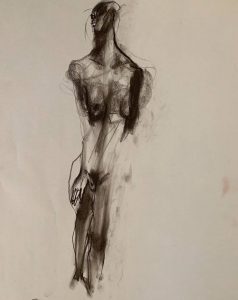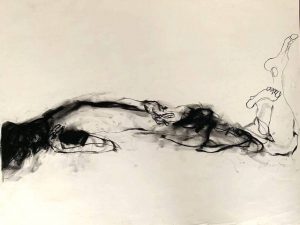Death & Failure (Upd: Sep 26, ’22)
“Butoh is a corpse standing straight up in a desperate bid for life.” – Tatsumi Hijikata7
If there is one image that could be associated with Butoh outside of the demon or sick body, it is death, especially for Ankoku Butoh coined by Tatsumi Hijikata (Ankoku meaning dark). Death, to many, is bleak shadow, but it need not be. It can be a means of self-empowerment.

Resonating with one’s own mortality is one of the deepest resonances. Do we really have a choice? Ushio Amagatsu once stated, “Butoh belongs both to life and death. It is a realization of the distance between a human being and the unknown. It also represents man’s struggle to overcome the distance between himself and the material world.”¹
In Kaze Daruma, Tatsumi Hijikata stated,
“I would like to make the dead gestures inside my body die one more time and make the dead themselves dead again. I would like to have a person who has already died die over and over inside my body. I may not know death, but it knows me.”
If this quote sounds paradoxical, it is because Hijikata also used the notion of the dead to mean the domesticated. Our human domestication is actually the corpse, not unlike a zombie. We are already dead. This is why Hijikata also stated, “We are broken from birth. We are only corpses standing in the shadow of life.”6 We need to die more, to reach the land of the living or what I call vigor mortis (see Vaporizing section ahead).
Consistently dying (or surrendering) is the way in which the dancer can drop one qualia and immediately dive deeply into the next one as in the case of jumping wild.
The dead was also connected to ancestors. Hijikata’s dead/missing sister to him was like an ancestor spirit that influenced his world: “I often say that I have a sister living inside my body. […] For me to fall is for her to fall. […] A dead person is my butoh teacher.”²
Death also shares qualia with statue and freeze, and for me is deeply associated with nurture:
DEATH = SURRENDER = NURTURE (hence we can rest in peace… finally)
Exercise 1: Inhalation Birth, Exhalation Death
We enter the world with an inhalation and exit with an exhalation. So with every inhalation you take, be born, and with every exhalation, die.
Exercise 2: Styles of Death
How do you die elegantly? How do you die in a cute way? How do you die in a sexy way?
Exercise 2: Die & Die
Based off of Hijikata’s quote above, what is it like to die and die over and over again? It is not enough to die once, we must die over and over again.
Psychodramas/Rituals Where Death Is a Theme
Shadow & Flower — Transforming our shadows to light.
Last Performance, Five Minutes — Making performance count.
Ouroboros — Resonance with the entire spectrum of age and the between death and life.
Automatic Saboteur — Brings to the surface the cognitive distortions of mind reading and/or personalization from Cognitive Behavior Therapy.
Happy Quickstand Victim — Edge or death resonance. Transformation.
Ego Feast — Ego resonance. Clown. Death.
Empathy Victim — Brings to the surface the cognitive distortion of control fallacy from Cognitive Behavior Therapy. Also on the difficulty of being an empath.
Passion of The Christ — Sacrifice. Dark world resonance.
Blue Flower — Overcoming depression.
Vaporizing/Imaginary Dance
When Tatsumi Hijikata performed the weakened body in his last performance called Quiet House, he was in reality performing the vaporized body. Vaporization is the potential, invisible world body, which is of endless qualias. In the vaporized body performance, there are two things taking place: (1) The 3d world body that appears weak or in ash body, dead body or statue/freeze. (2) The multidimensional invisible world or Subbody.

Hijikata was fond of Antonin Artaud of the Theater of Cruelty, and a term known as the body without organs (BwO) mirrors that of the vaporized body. Deleuze and Guattari were also fond of Artaud and make extensive use of the term as well. D & G say of the BwO: “The body without organs is not a dead body but a living body all the more alive and teeming once it has blown apart the organism and its organization.”² It is thus “alive and teeming” because it is in the multidimensional world.
The corpse or frozen body in butoh theater is a means to an end. D & G say, “You invent self-destructions that have nothing to do with the death drive. Dismantling the organism has never meant killing yourself, but rather opening the body to connections that presuppose an entire assemblage, circuits, conjunctions, levels and thresholds, passages and distributions of intensity, and territories and deterritorializations measured with the craft of a surveyor.”³ In other words, the dead or frozen body is means to an ultimate novelty and inner-creator.
Mono No Aware
“If man were never to fade away like the dews of Adashino, never to vanish like the smoke over Toribeyama, how things would lose their power to move us! The most precious thing in life is its uncertainty” – Donald Keene³
In Japanese aesthetics, Mono No Aware is the awareness of the transience or impermanence (inevitable death) of things. Aware roughly translates to pathos and Mono to things. It is the property of transience itself that can make something more beautiful.4 Mono No Aware is hence a fitting aesthetic for butoh with its fixation on death (hence life).
Right now, are you ready to die?
“A man who has learned how to die has unlearned how to be a slave.” – Montaigne
The title may provoke fear (e.g. I don’t want to think about that) and/or bitterness (e.g. finally, yes, now I can escape this retched place). On the other hand, there may also be gratitude (e.g. yes, this moment is as good as any other moment to be on my way), a ““Yes, And.”
The former appears to be rooted in the preoccupation with control and the latter with the acceptance or harmony with one’s space-time. In his mention of Mono No Aware, Donald Keene says, “the acceptance and celebration of impermanence goes beyond all morbidity, and enables full enjoyment of life.”³ This is a resonance to be reached by the butoh dancer. Endings do not always need to have negative connotations, though many last moments do seem to carry much suffering.*
The inscription upon Hell’s gate in Dante’s Inferno comes to mind: “Abandon all hope, ye who enter here.” Though the immediate interpretation of the sign may denote doom’s inevitability, it might just be the key out of hell. The antidote may be to surrender so that one could finally free oneself from the suffering. Oftentimes it appears that pride in our ability to change what may be unchangeable keeps us in hell.
So if the question of death right now frightens or provokes bitterness, perhaps there are some shadows to face that feed off the ironic limitation of an overabundance of pride (inflated ego) in being the controller. In Dante’s Inferno, the very flapping of the devil’s wings (from the desire to escape) caused the air to cool and keep the ice frozen, which kept him trapped. How long, how many vicious circles must go on till we can fold the cards? Knowing when to retreat is a warrior’s skill in Sun Tzu’s Art of War and the mark of a sage in the Tao Te Ching.
What image, then, bares so much more inevitability than that of death? Might as well embrace and even think often of death, for death may approach at any second. It can be a serendipitous thing, for death is letting us be, for now.
Failure
“Don’t concern yourself with moving skillfully. Don’t abandon hope if a perfect solution isn’t found. Failure is a powerful stimulant; it only makes you all the more determined to be more painstaking …. There’s no standard approach; find your own way.” – Kazuo Ohno5
Failure is an unavoidable aspect of life, and one which begs for resonance. Like in death, there is nowhere else to go but into the hole of putrefaction or resurrection. One will either get bitter (antithesis) or better (synthesis). As Tatsumi Hijikata poetically worded it, “I would like to be sitting, without even a passport, smack in the middle of a mistake.”9
Psychodramas/Rituals On Failure
Sleep Paralysis Victim — Resonating/overcoming sleep paralysis.
Disco Nightmare — Being limited, stuck body, being bullied.
Flopping Imbecile — Clown. Anti-fighting. Ineptitude.
Body Failure
Take any movement or qualia and cut that energy at any point. For instance, if I want to execute throwing a ball, I might wind, and midway into the throw, something happens, and the energy is cut. Perhaps you might even see the movement executed via the imagination. Your body itself has failed you.
The ability to instantly cut or let-be-cut is a jumping wild skill.
Failure For Itself
During butoh research, we might fall or have an accident of some type. Resonate with the unexpected. Own the error. Become an errorist. Own the error so much that the audience may never know there was an error. You may even copy the error and keep utilizing this in the dance. This is utilizing the improvisational theater concept of “Yes, And…” to the maximum.
Meta-Failure For Itself
If we do have a psychological reaction because of our failure (frustration, etc.), dance it. Whatever qualia or body gesture occurs as a result of failure, dance it. You can even fake that you were affected.
Pop Death & Zombie
A possible bridge between the butoh world and the daily world is that of zombie. Zombie is also a “dead body” in a most surface level. Perhaps if the concept of zombie were to be taken deeper and deeper it would start to resemble the butoh qualia.
Jenny Lawson has written about the zombie type and its deep connection eating. Jenny states, “Eating connects us in a web of ongoing transformation between self and other, between internal and external and between living and dead.”8
Devotional Death
Prostration is a form of surrendering and lowering ourselves completely down to that which is beyond us (Source/God). To those who resonate, we can always keep this formula with us: DEATH = SURRENDER TO SOURCE.

